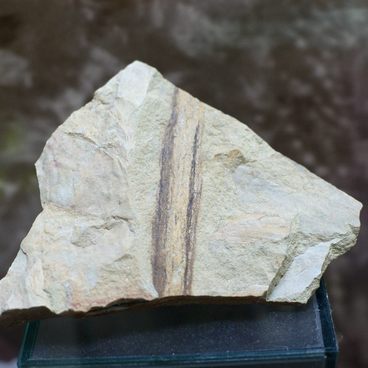Sandstone is a sedimentary rock. It consists of different compounds: grains of sand cemented by clayey, carbonate, and siliceous materials. Sandstones also include mineral deposits; they are very porous, easily permeable, and often retain gas, oil, and water.
Specimen of Sandstone with a Fossil Fern Imprint
Время создания
300–240 million years.
Размер
Kuzebai Gerd National Museum of the Republic of Udmurtia
Выставка
0
Открыть в приложении#1
Specimen of Sandstone with a Fossil Fern Imprint
#6
In the collection of the Museum, you can see a specimen of sandstone with an imprint of a fossil fern branch from the Carboniferous Period of the Paleozoic Era, which is about 300 million years old. Local archaeologists have discovered it in the Malopurginsky District of the Udmurt Republic.
#7
During the Carboniferous Period, the climate was warm and humid. Wetlands were mostly covered with tree ferns able to reach a height of up to 40 meters.
#5
Some plants had their stems so weak that a strong wind was enough to break them. Trunks of collapsed trees were flooded with water, then silted, and sanded. This way, the oxygen supply was cut off and did not cause the decomposition process; the remains of the trees were preserved. This period of the evolution of life on Earth is called Carboniferous as the accumulated layers were gradually compacting and turning into peat and coal.
#13
Today, ferns are found almost all over the planet. Most of them grow in the warm tropical forests of the Amazon, Mexico, Panama, Nicaragua, and many other countries.
#12
In Russia, ferns mostly grow in the Caucasus and the Far East, but some species can also be found in temperate forests stretched from the central part of the country to the northern taiga. The majority of them are perennial eagle ferns and various wood fern species.
Папоротник Многоножка обыкновенная (Polypodium vulgare). Источник: commons.wikimedia.org
#10
‘I was trying to keep to open spaces, where there was less woody debris. Along the way, I noticed a poisonous white hellebore with coarse pleated leaves; a cosmopolitan fern: an eagle fern, which had the leaves that really looked like the wings of an eagle. . . .’
In 1930, the traveller Vladimir Arsenyev wrote about the eagle fern in his book Through the Taiga.
#11
Ferns are omnipresent; they can even grow on branches and trunks of large trees, in rock crevices, as well as on house walls and along roadsides.
читать дальшескрыть
00:00
00:00
1x
Specimen of Sandstone with a Fossil Fern Imprint
Время создания
300–240 million years.
Размер
Kuzebai Gerd National Museum of the Republic of Udmurtia
Выставка
0
Открыть в приложении
Поделиться




